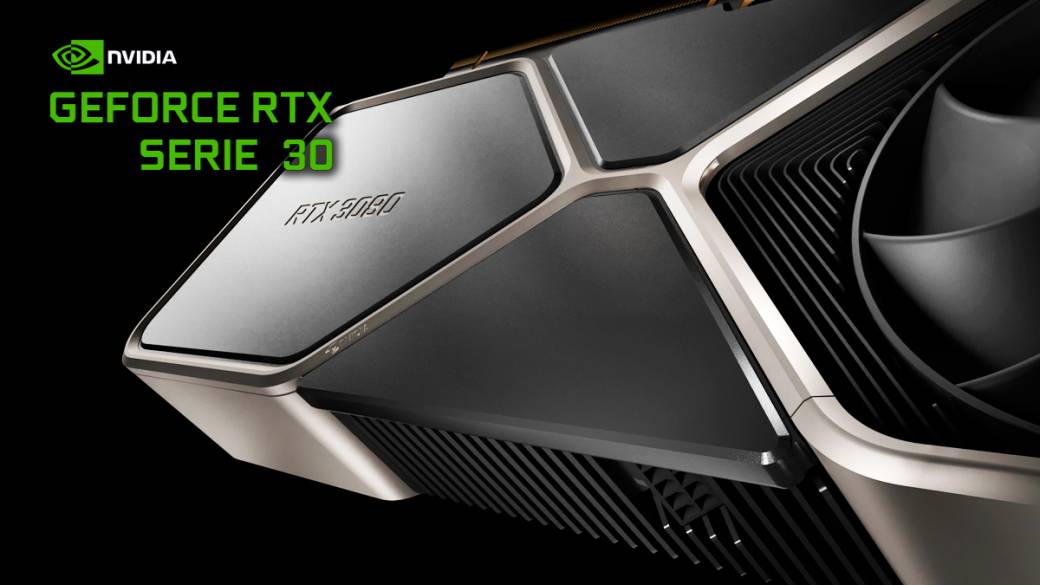
It promises the biggest leap in quality and performance in its 27-year history. And the numbers support it.
NVIDIA had been announcing the date of this presentation as the greatest advance in PC Gaming since 1999, the year in which this manufacturer presented its first GeForcey, indeed, it was a huge leap in the graphic quality of video games. The announcement could sound pretentious and, being a bit scathing, almost desperate, given the situation of this manufacturer in the last two years, since the launch of its first RTX. This week’s announcement comes to remove everything, including prices.
In this decade, hardware has seen how the manufacture of processors began to collide with many limits, breaking for the first time the well-known Moore’s Law, and suffering a worrying technological stagnation. It was time to change technology, to take risks, to seek solutions outside the traditional route. AMD has taken lessons from this with its Ryzen family. NVIDIA followed suit and went for a very risky move. He abandoned the fight for the highest frequencies and pure performance in Frames Per Second and marked a new route towards realistic lighting, with Real-time Ray Tracing, and the use of Artificial Intelligence.
The presentation of the first RTXs in 2018 left users cold. They were a pretty promise, based on tech demos and a handful of games that I was getting the least out of, with the drag of a very high price and a leap in “classic performance”, pure speed, that hardly made any difference from the previous generation .
In these two years it has been shown that NVIDIA’s bet was the right one. AMD has been forced to match the bet and, above all, the new generation of consoles will have immediately normalized the use of Ray Tracing or RTX. Nowadays, no video game developer can have ambitious aspirations if he does not also follow that path marked by NVIDIA. The question that remains is whether Ray Tracing is the future because it was the natural leap in graphics technology or because NVIDIA opted for it.
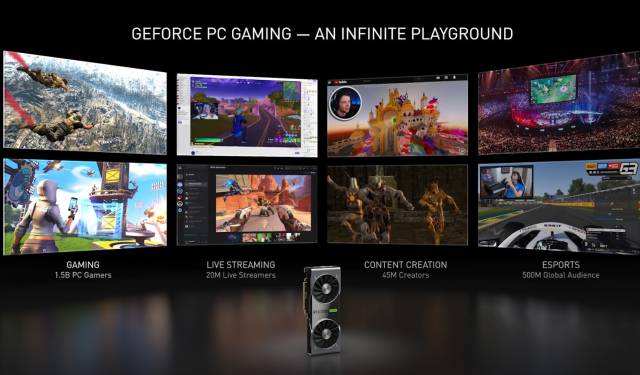
If anything, NVIDIA was missing something fundamental. The product. Because one thing is to develop a technology and another thing is to make money with it. Up to this point NVIDIA was being bullied with AMD Radeon, a product that objectively offers better performance than RTX at a lower price. Of course, without RTX, but given the titles on the market that take advantage of this technology and the way they do it, is it worth paying for it? Too many users (for NVIDIA) have decided no, that RTX is not worth it.
In this context, NVIDIA was playing everything to the card that they just showed. And everything indicates that they have won.
NVIDIA slams the table: the real next gen
In a presentation of less than forty minutes, “Jensen” Huang, CEO of NVIDIA, from the kitchen of his house and with his characteristic leather jacket, turned everything upside down.
After due reference to COVID-19, the presentation began with an emotional (at least for the most geeks) video in which the journey of NVIDIA from GeForce to today was reviewed, with fragments of the demos that over the years we have created expectations about the new hardware of the brand.
As a classic at NVIDIA by now, video began by introducing new technology and escalating in interest as the minutes passed. We will try to reproduce that same script. Huang got into the subject and wanted to make clear the importance of dedicated hardware for the treatment of lighting and artificial intelligence as a tool to improve the graphic experience without consuming hardware resources. To put the RTX in situation, he insisted on the progressive adoption of all the developers of this technology, using as heavy ammunition the news that Fortnite also adopts “its” lighting.

As a first novelty, NVIDIA presents REFLEX, a technology aimed at optimizing communication between CPU and GPU so that latency is considerably reduced, up to 50% according to Huang. It is a technology aimed at the most competitive in the FPS genre, for which a tenth of a second can be essential. The rest of us mortals will take advantage of this technology equally, although it does not suppose similar benefits.
This technology will be based on a component that, for a few years now, has become essential for any player: the monitor. On this premise NVIDIA presents a new panel that will be used by its first partners, Acer, Alienware, Asus and MSI, and that marks what since the gaming monitor fever began we dreamed of as ideal: a really fast IPS panel. And so fast, because what is presented is an IPS monitor with no less than 360Hz. No further specifications were given, but we do expect a 27 ”1440p format that would become by far the best gaming monitor seen to date.
Reflex technology would reach its maximum meaning in a monitor that allows such drawing frequencies. Proof of this is that the monitor would be the port to which we would connect our mouse, avoiding the passage through the PC and the consequent latencies. For most of the mortals for whom we have a long way to go to aspire to such hardware, this NVIDIA Reflex, which is expected to be integrated into NVIDIA GEFORCE Experience with backward compatibility up to the 900 series, will help us to analyze which components increase our latency the most and try improve them.
Another novelty destined for the GEFORCE Experience is the so-called NVIDIA BROADCAST. A technology that will be limited to owners of RTX and that promises to be the dream of any “streamer”. The power of AI in this hardware aimed at giving these content creators possibilities. It allows from keeping the image centered on the person, eliminating any background noise other than their voice and, here comes the most interesting thing, treating the background of the image so that it can be blurred or replaced by any other background, including the image of the game being broadcast. This technology is the death of the classic chroma or green background screens. The advantages are so many that it will be difficult for there to be YouTubers who do not take advantage of them.
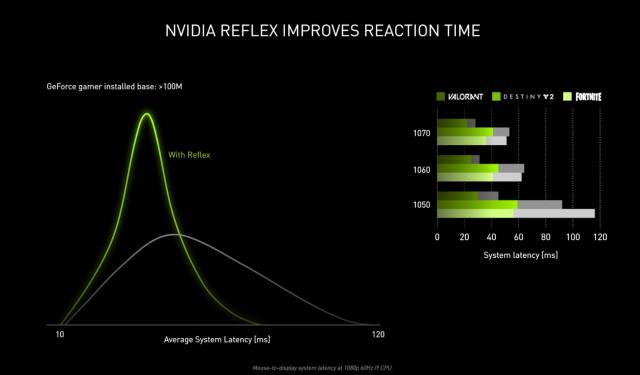
Finally, just before the hardware presentation, NVIDIA OMNIVERSE MACHINIMA was presented, another AI-based tool, this time aimed at creating visual content. The MACHINIMA creators take advantage of the graphic resources of the games to create their own sequences. This Omniverse puts in your hands the power of the RTX AI to calculate the lighting and texture of your creations, as well as other tools that we find extremely interesting, such as motion capture without the need for special suits, from any video, the transformation of video images (2D) into 3D objects using AI, or the interpretation of a speech by an avatar, fully automated.
These types of advances go unnoticed in a presentation like this one, which is also directed at a hardware product, but they are small wonders that in themselves represent a great advance in the possibilities of any creator. And all thanks to the AI of a graphics card.
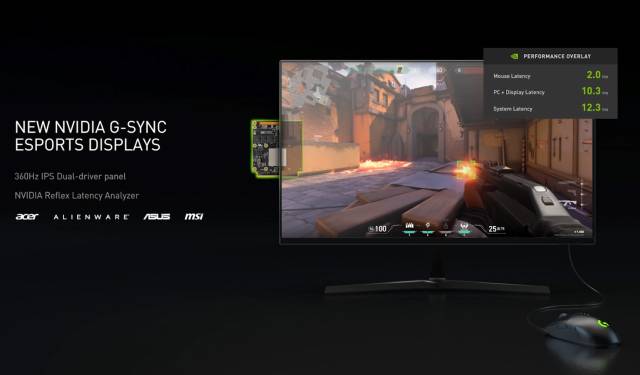
RTX 3070, 3080 and 3090
And finally it was time for the hardware presentation. The first to appear was, as usual, the 80 series. Followed by the 3070, which we already dreamed of, and ending with the punch at the 3090 table, an almost obscene hardware in terms of power and performance.
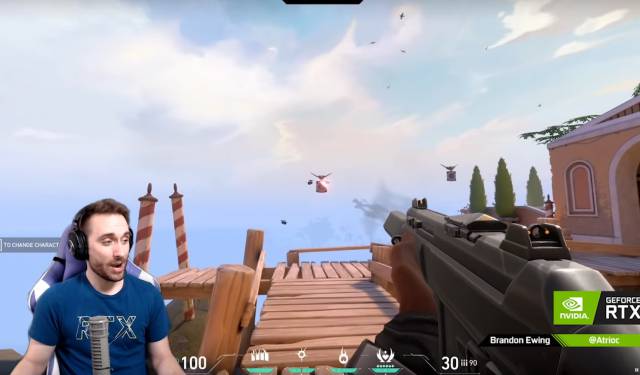
The first thing that stands out about the new hardware is its appearance. All of them are really big, not suitable for any box, with the requirement to cover three slost with their enormous span and twelve-pin power connections. The cause of this exaggerated size is found in the new cooling system they have. Thanks to a double system of fans and a hollow and ribbed body through which air currents circulate, heat evacuation is significantly improved. The fans will draw cool air from the case and expel it either directly to the outside, through the rear fan, or to the top of the case, through the front fan. According to NVIDIA the improvements in dissipation and noise are notable.
In return, we will have some pretty ugly and large cards. But it is not an issue that should concern us, because manufacturers such as MSI or Gigabyte have already announced designs different from this “Founders Edition”, much more conventional.

But the really big news comes when Huang begins to describe what he is holding. Perhaps the biggest technological leap is due to the passage from the 12 nanometer technology of the previous Touring generation, to the 8 nanometer of these processors manufactured by Samsung. The advantages are obvious with regard to the inclusion of a greater number of transistors, less electrical consumption and less heating.
And to demonstrate the advantages of this technology we have figures, many figures. While much of the specs for the new RTXs had been leaked, it was jabbed into bone with the number of CUDA cores. The smallest of this Ampere series, the 3070, will have 5888 CUDA cores, 8704 the 3080 and an absurd 10496 CUDA cores for the 3090.
The possibilities offered by this processing power are almost endless, especially in rendering, since they suppose a transversal output that is far from the classic rate of operations per second, being a much more adaptable and scalable tool. The first thing that comes to mind is Artificial Intelligence and DLSS 2.0. Those developers who first take advantage of the optimal use of this hardware, will achieve a graphical performance that will make a big difference compared to those who do not put themselves to it. NVIDIA once again marks the path to follow in the creation of games.
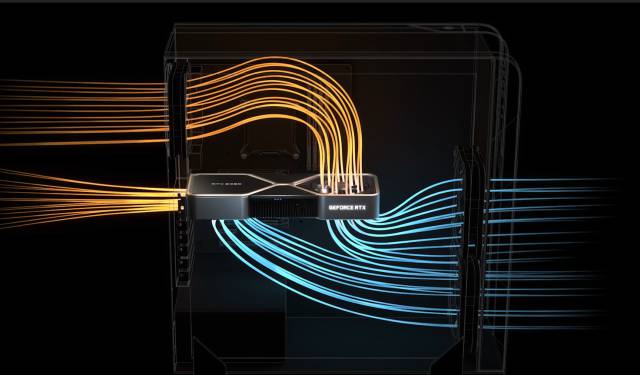
And special emphasis must be placed on Artificial Intelligence. Mr. Huang made several references to AI, citing it as the most important technological advance of the last decade. And regarding DLSS, although it left us a bit cold with its version 1.0, given the poor results it offered except in certain titles, in its version 2.0 it has been confirmed as the greatest advance that NVIDIA has offered us in its latest GPUs, much beyond the usual RTX.
The examples shown by NVIDIA in the presentation on the possibilities of DLSS open us to a world of high frequencies, in great resolutions, accessible to a much more humble hardware than required under normal circumstances. Play 4K? We are already talking about doing it at 8k!
This second generation of RTX cores (and third generation of Tensor cores) requires hardware that allows them to work at full performance, without bottlenecks. In that regard, the need for very fast memory is the first obvious. The new RTXs will feature the latest memory technology, the blazing-fast GDDR6x. The width of the memory interface will reach from 256bit of the 3070, 320bit of the 3080, to 384bit of the 3090.
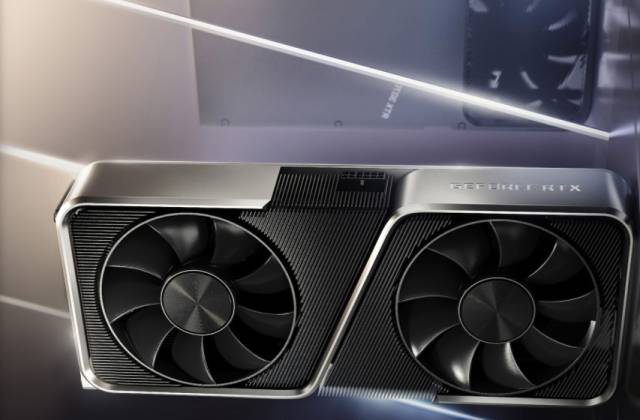
On the other hand, the new cards will make use of the new DisplayPort 1.4a, HDMI 2.1 and PCIe 4.0 channels. This does not mean that they will not work on boards with lower ports, so it is not necessary to change motherboards. What it means is that the door is open to data flows that greatly increase the current ones and, indeed, to start talking about 8K “gaming” as a real possibility.
The solution for communication between CPU and GPU, in terms of compression and data transmission, NVIDIA finds it in its new NVIDIA IO technology, based on the storage of much of this information directly on the graphics card. In this way, the loads will be instantaneous, with a similar operation to that of the system’s RAM memory. Hence the minimum GDDR6x memory is 8 GB for the 3070, 10 for the 3080 and 24 GB for the 3090.
Consumption was concerned, due to the already planned 12-pin electrical connection, but they have not soared. Samsung’s 8nm manufacturing technology obviously contributes to this. The 3090 consumes 350W, the 380 about 320w and the 3070 stays at 220w content. With these consumptions, it is advisable to opt for 750W power supplies, although the 3070 may have enough with a 650W one.
A detail that has almost gone unnoticed is the disappearance of the SLI capabilities of these cards and their well-known NVlink. Only the 3090 maintains that possibility, given its more than predictable use in development environments. For the others, there is no possibility of adding two graphics cards. SLI is dead.
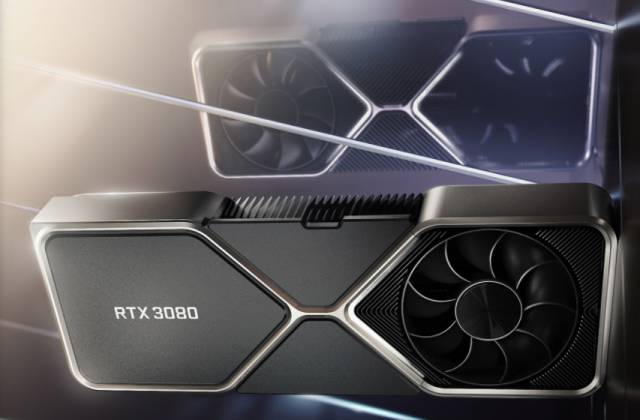
Superlative performance
Unlike other presentations, no performance graphs have been shown, or comparisons. Only a very generic table has been shown that places this new generation with respect to the previous one. Thus, the 3080 would perform more than twice that of the 2080, 80% more than 2080 Super and 70% above 2080Ti, all based on estimates that can be obtained from the little information offered.
As for the 3070, the performance would exceed the 2080Ti. Let’s remember that the 2080Ti are around € 1,300 right now. On the 3090, being such a particular hardware and so conditioned by the rest of the hardware and software used, it is enough to know that it comfortably surpasses the Titan RTX (which exceed € 2000).
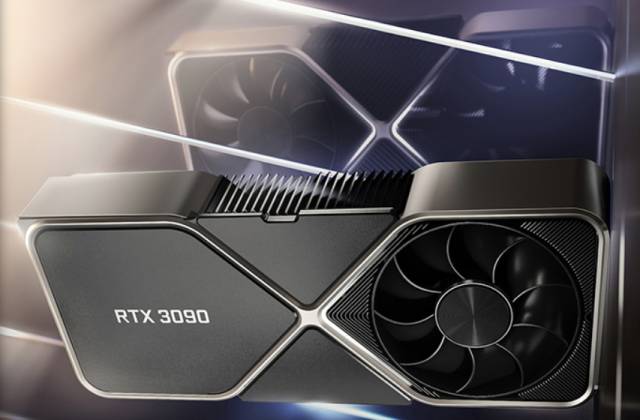
These performance estimates must be taken with tweezers, because it has not been specified under what conditions they are obtained and, above all, without considering the use made of the DLSS. Everyone knows that well implemented DLSS 2.0 doubles the performance in terms of FPS, so we will have to wait to test the cards and really see what the differences are in any title, take advantage of DLSS well or not.
In any case, we must emphasize that the CEO of NVIDIA has wanted to make it clear that the jump in performance between the RTX 20xx (Touring) and the new RTX 30xx (Ampere) is the largest that has occurred in the 26-year history of the company.
This circumstance makes us especially happy, because if the 2018 RTX has been criticized for something, it is not offering a performance gain that justifies its price, beyond technologies that had not yet been standardized.
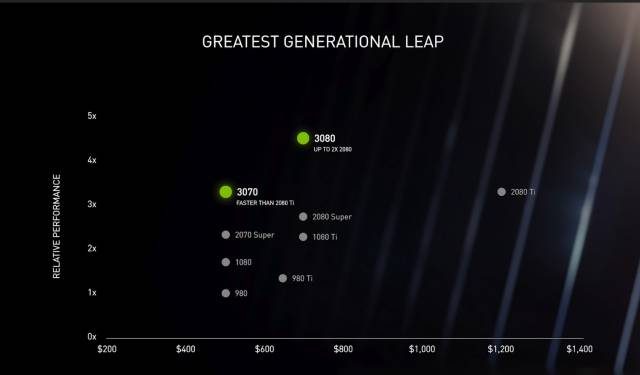
Pricing and availability
To put this performance into perspective and the impact that this new hardware may have on the market, we are missing one fundamental piece of information: price. And here we have one of lime and another of sand. Initially, the prices given by Huang have been lower than expected, making the new RTX very desirable hardware. We did not remember a launch where the performance grew so much, while the price was reduced compared to the previous generation, but it is. The prices offered by NVIDIA are $ 1,499 for the 3090, $ 699 for the 3080 and a more than sweet $ 499 for the 3070.
This scenario effectively changes the graphics hardware market radically. Output takes away all the meaning of the current generation of NVIDIA cards. It makes no sense to buy any of them, as had already been demonstrated since NVIDIA cut production of all of them, except for the 2060 Super. This 2060 will remain as the cheapest product within the RTX range and it will be necessary to see how its price is reduced once the 3070 reach the market with enough volume.
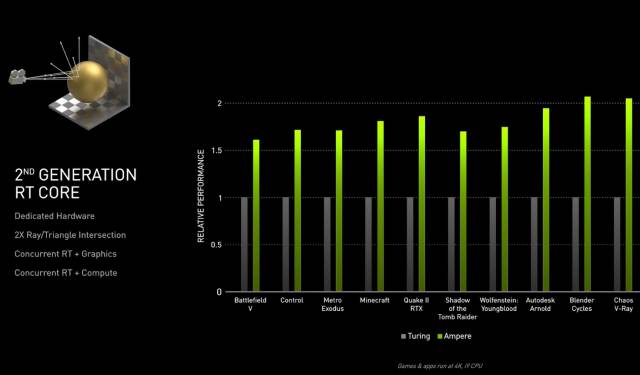
As for the higher-end, the 3070 literally destroys any 2080, with 40% more CUDA cores than the 2080Ti, it delivers superior results for half the price. The 3080 becomes the new object of desire, allowing you to play in 4k resolutions at more than 60FPS and with RTX activated for less than $ 700 … a dream until yesterday.
Regarding the 3090, it is a product aimed at showing muscle and clarifying how far NVIDIA can go. His departure means the immediate annihilation of the Titan RX. In fact, NVIDIA with this 3090 makes several paradigm shifts. The most obvious is that it introduces its top of the range within the environment and nomenclature of the rest of the cards, unlike what it had been doing with the Titan. The second is that it will allow other manufacturers to produce this product. Unlike Titan, made exclusively by NVIDIA, we will see 3090 from all their partners.
Surely that is the reason for the change, since these manufacturers will not hesitate to tempt the hearts and pockets of players claiming that it is the most powerful card for games ever seen. And it really is, but it would be necessary to put everything in perspective. It is too expensive and powerful as a game card. As simple as that. Hence, NVIDIA presented it using a video where several youtubers played Control on an 8K OLED panel with RTX enabled. Without a doubt, it must be quite an experience, but it seems a bit far away, given the outlay that we would have to make not only on the GPU, but also on the rest of the equipment, from the monitor, to the motherboard, memory, CPU …
In short, 3090 mainly becomes a product for developers, in addition to being a challenging look at an AMD, which announces its new Radeon NAVI as a card capable of ending the 2080 … And those 2080s are already dead and buried, but it has been envy itself that has annihilated them with about 3070 of $ 499.
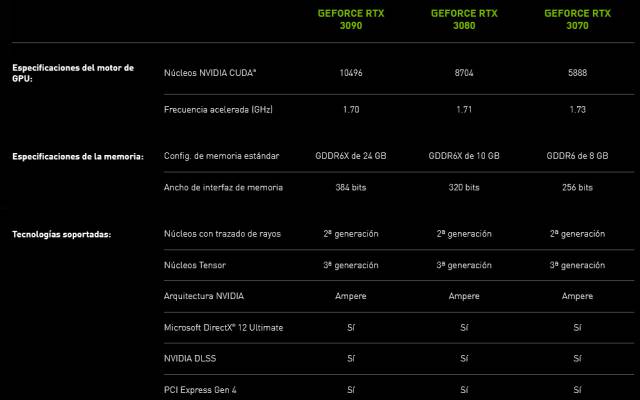
Regarding availability, both 3080 and 3090 will begin to arrive this month of September. For the juicy 3070 we will have to wait until October. The jug of cold water arrives, as almost always, when prices for Spain are published almost immediately. As in South America, rates, tariffs and distribution costs end up making prices very different from those advertised.
Thus, the 3090 will be sold from € 1,549 ($ 1,837 compared to the announced $ 1,499). The 3080 will start at € 719 ($ 852 vs. $ 699) and the 3070 will go above € 519 ($ 616 vs. $ 499 in the US).
Conclusions
Favorable. Very favorable. The RTX 20xx Series has left us a bit cold over these two years. Your buyers have literally paid for the invention. It has been very expensive hardware that was nothing more than the prototype of what was to come. However, NVIDIA cannot be blamed for its decision because today it has been confirmed as correct. The RTX is normalized in games. Neither developers nor hardware manufacturers will be able to do without this technology. A clear example of this are PlayStation 5 and Xbox Series X, or NVIDIA’s own direct competition, AMD.
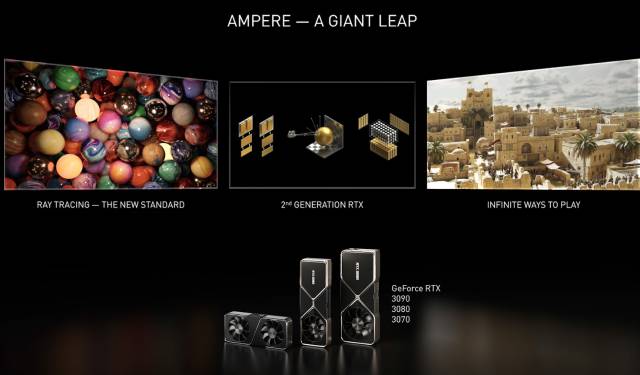
The leap in visual quality that this technology allows is the largest in more than a decade. At last. Those of us who have spent a lifetime playing with a PC wept bitterly at the more than evident stagnation in the graphic quality of video games. Do we remember the graphic quality of Crytec’s Crysis? Well, that game is from 2007 and in these thirteen years the graphic evolution has been simply nil. Until now.
Hence, regardless of NVIDIA’s business policies, we are grateful that they dared to step in a new direction. That, at last, they have made us see the future. It may seem exaggerated, even flattering, but we invite you to see the video of the marbles that NVIDIA uses to present this generation. The amazing thing about this video is that it is entirely generated in real time. There is no pre-rendering, there is no pre-calculated lighting, shadows and semi-darkness are calculated at the moment they are generated… This, in sum, offers us a conclusion. After seeing literally thousands of technological demos, this is the first one capable of fooling the brain and making us doubt whether we are dealing with a real sequence or one generated by a PC graphics card. This type of quality was reserved for large graphics stations and companies such as Pixar or Light & Magic, but now we are talking about normalizing them, bringing them to our PC, to our games.
The much vaunted new generation of video games not only has its banners in the form of a console; it is also here on PCs. With the exception that while both Sony and Microsoft want a comparison with respect to the raster equivalent to the performance of a 2070 and lighting similar to a 2060, the arrival of this hardware literally doubles the graphic potential of their imminent consoles.
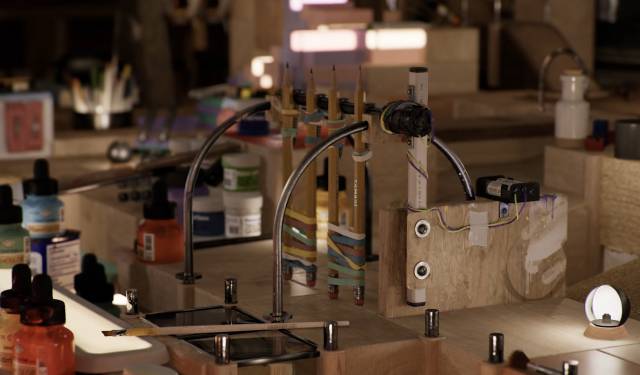
On the other hand, the prices are high, yes, but less than expected. It is a sad consolation, but at least today we have much more performance for the same price. Very bad news for AMD, but not as bad as it is for those users who recently bought their RTX.
Lastly, NVIDIA hasn’t just given game developers a boost. Monitor makers now have a good go at these RTXs. We have been dreaming for years of a monitor with the best image quality, IPS, and refresh rates and delays according to the highest demands. Just as there has been a short life expectancy for the RTX 20xx and any other hardware that does not take advantage of DLSS and RTX, the death of Full HD, 1080p, 60Hz and the sad TN panels is also signed … It does not seem too smart to bet on a monitor that does not have at least 1440p and 144hz, which seems like the next standard for gaming.
In terms of returns, it is too early to comment. It is essential to test them in our environment, but it is also promising. And it is promising because, unlike the previous generation RTX, developers have been optimizing their titles for a few years to get the most out of this technology. The commitment to Artificial Intelligence seems to us one of the best news that PC hardware has had in a long time. And ultimately, we may not be able to double the performance of current GPUs so easily at first, but it is something that will be achieved as new games take advantage of AI technologies such as DLSS.

Thus, there is still not much to talk about this new generation of NVIDIA GEFORCE and how it will be on the market. We eagerly await the first test units to put everything that they promise us today in its proper place.

